2013 DACIA SANDERO engine
[x] Cancel search: enginePage 89 of 146

4.1
ENG_UD8706_2Sommaire 4 (B90 - Dacia)ENG_NU_817-2_NU_Dacia_4
Section 4: Maintenance
Bonnet . . . . . . . . . . . . . . . . . . . . . . . . . . . . . . . . . . . . \
. . . . . . . . . . . . . . . . . . . . . . . . . . . . . . . . . . . . 4.2
Engine oil level . . . . . . . . . . . . . . . . . . . . . . . . . . . . . . . . . . . .\
. . . . . . . . . . . . . . . . . . . . . . . . . . . . . 4.3
Engine oil change . . . . . . . . . . . . . . . . . . . . . . . . . . . . . . . . . . . .\
. . . . . . . . . . . . . . . . . . . . . . . . . . . 4.5
Levels: . . . . . . . . . . . . . . . . . . . . . . . . . . . . . . . . . . . .\
. . . . . . . . . . . . . . . . . . . . . . . . . . . . . . . . . . . 4.6
brake fluid . . . . . . . . . . . . . . . . . . . . . . . . . . . . . . . . . . . . \
. . . . . . . . . . . . . . . . . . . . . . . . . . . . 4.6
engine coolant . . . . . . . . . . . . . . . . . . . . . . . . . . . . . . . . . . . .\
. . . . . . . . . . . . . . . . . . . . . . . . 4.7
power-assisted steering pump . . . . . . . . . . . . . . . . . . . . . . . . . . . . . . . . . . . . \
. . . . . . . . . . . . 4.8
windscreen washer reservoir . . . . . . . . . . . . . . . . . . . . . . . . . . . . . . . . . . . . \
. . . . . . . . . . . . . 4.8
Filters . . . . . . . . . . . . . . . . . . . . . . . . . . . . . . . . . . . . \
. . . . . . . . . . . . . . . . . . . . . . . . . . . . . . . . . . . . \
. 4.8
Battery . . . . . . . . . . . . . . . . . . . . . . . . . . . . . . . . . . . . \
. . . . . . . . . . . . . . . . . . . . . . . . . . . . . . . . . . . . 4.9
Bodywork maintenance . . . . . . . . . . . . . . . . . . . . . . . . . . . . . . . . . . . . \
. . . . . . . . . . . . . . . . . . . . . . . 4.10
Interior trim maintenance . . . . . . . . . . . . . . . . . . . . . . . . . . . . . . . . . . . . \
. . . . . . . . . . . . . . . . . . . . . . 4.12
Page 90 of 146
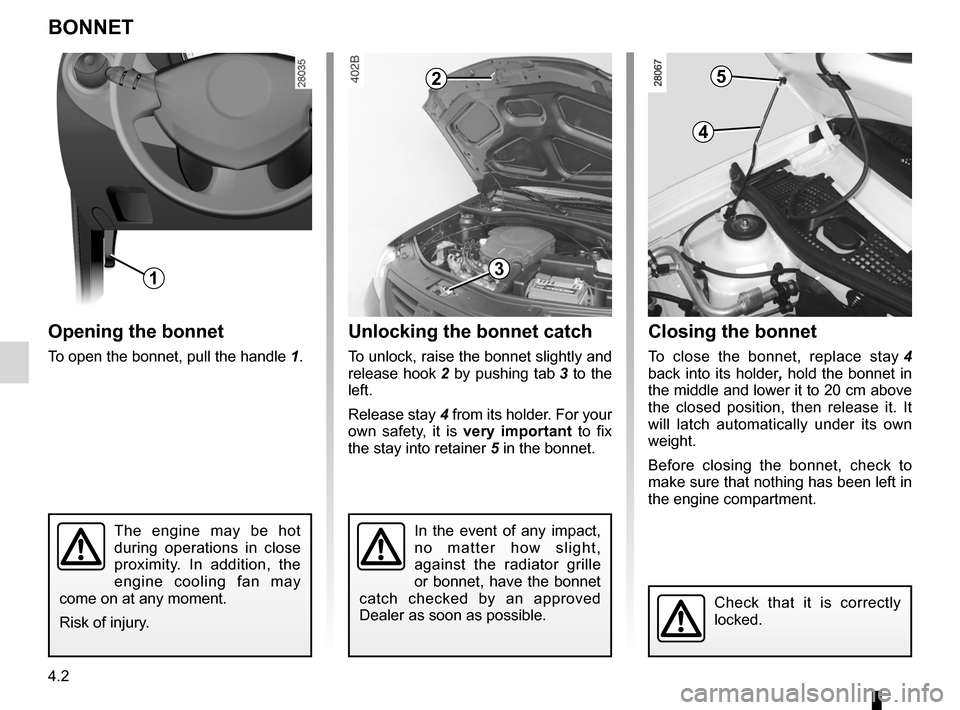
bonnet...................................................(up to the end of the DU)
4.2
ENG_UD5590_1Capot moteur (B90 - Dacia)ENG_NU_817-2_NU_Dacia_4
Capot moteur
BONNET
Opening the bonnet
To open the bonnet, pull the handle 1.
Unlocking the bonnet catch
To unlock, raise the bonnet slightly and
release hook 2 by pushing tab 3 to the left.
Release stay
4 from its holder. For your own safety, it is very important to fix
the stay into retainer 5 in the bonnet.
Closing the bonnet
To close the bonnet, replace stay 4 back into its holder, hold the bonnet in the middle and lower it to 20 cm above the closed position, then release it. It will latch automatically under its own weight.
Before closing the bonnet, check to make sure that nothing has been left in
the engine compartment.
The engine may be hot during operations in close proximity. In addition, the engine cooling fan may come on at any moment.
Risk of injury.
In the event of any impact, n o m a t t e r h o w s l i g h t , against the radiator grille or bonnet, have the bonnet catch checked by an approved Dealer as soon as possible.Check that it is correctly locked.
1
2
3
4
5
Page 91 of 146
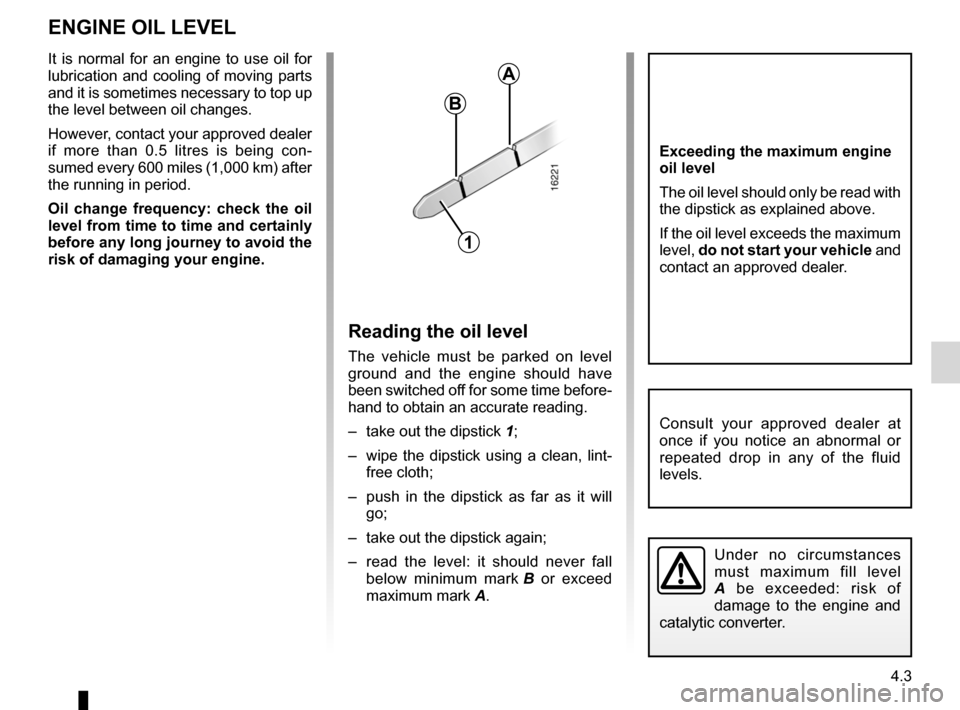
capacity of mechanical components......................(current page)engine oil ..............................................(up to the end of the DU)dipstick..................................................(up to the end of the DU)levels ....................................................(up to the end of the DU)maintenance:mechanical ......................................(up to the end of the DU)
4.3
ENG_UD5591_1Niveau huile moteur/Vidange moteur (B90 - Dacia)ENG_NU_817-2_NU_Dacia_4
It is normal for an engine to use oil for lubrication and cooling of moving parts and it is sometimes necessary to top up the level between oil changes.
However, contact your approved dealer if more than 0.5 litres is being con- sumed every 600 miles (1,000 km) after the running in period.
Oil change frequency: check the oil level from time to time and certainly before any long journey to avoid the risk of damaging your engine.
Niveau huile moteur
ENGINE OIL LEVEL
Reading the oil level
The vehicle must be parked on level ground and the engine should have been switched off for some time before- hand to obtain an accurate reading.
– take out the dipstick
1;
– wipe the dipstick using a clean, lint
- free cloth;
– push in the dipstick as far as it will
go;
– take out the dipstick again;
– read the level: it should never fall
below minimum mark B or exceed
maximum mark A.
A
B
1
Exceeding the maximum engine oil level
The oil level should only be read with the dipstick as explained above.
If the oil level exceeds the maximum level, do not start your vehicle and contact an approved dealer.
Under no circumstances must maximum fill level A be exceeded: risk of damage to the engine and catalytic converter.
Consult your approved dealer at once if you notice an abnormal or repeated drop in any of the fluid levels.
Page 92 of 146
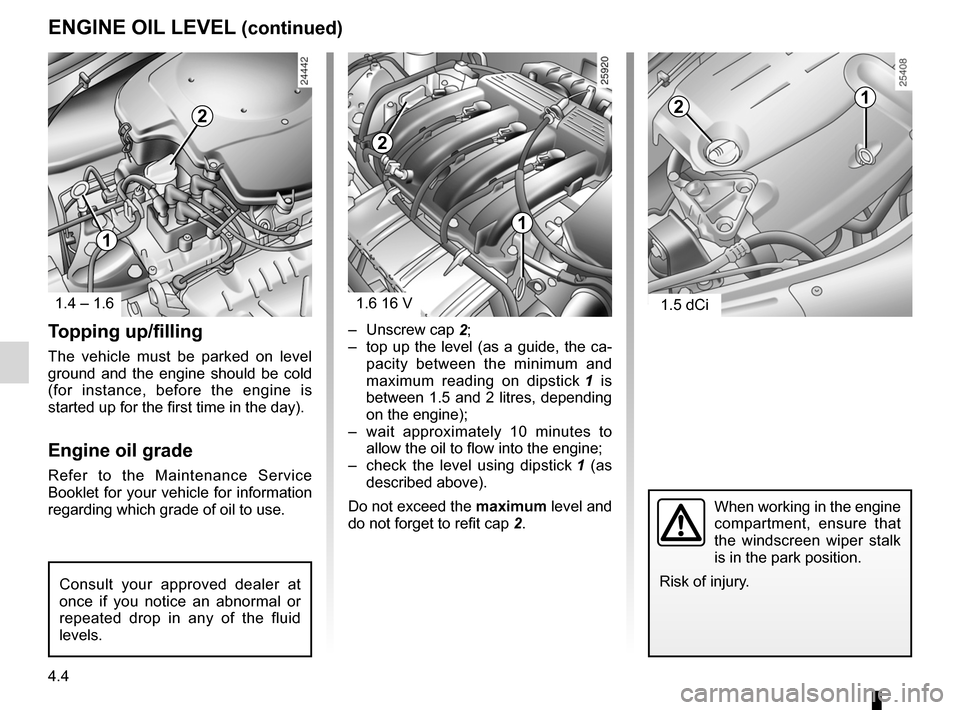
engine oil grade ....................................(up to the end of the DU)
4.4
ENG_UD5591_1Niveau huile moteur/Vidange moteur (B90 - Dacia)ENG_NU_817-2_NU_Dacia_4
JauneNoirNoir texte
ENGINE OIL LEVEL (continued)
Topping up/filling
The vehicle must be parked on level ground and the engine should be cold (for instance, before the engine is started up for the first time in the day).
Engine oil grade
Refer to the Maintenance Service Booklet for your vehicle for information regarding which grade of oil to use. –
Unscrew cap
2;
– top up the level (as a guide, the ca- pacity between the minimum and
maximum reading on dipstick 1 is between 1.5 and 2 litres, depending on the engine);
– wait approximately 10 minutes to allow the oil to flow into the engine;
– check the level using dipstick 1 (as described above).
Do not exceed the maximum level and
do not forget to refit cap 2.When working in the engine compartment, ensure that the windscreen wiper stalk is in the park position.
Risk of injury.
2
1
12
1
2
1.4 – 1.6 1.6 16 V 1.5 dCi
Consult your approved dealer at once if you notice an abnormal or repeated drop in any of the fluid levels.
Page 93 of 146
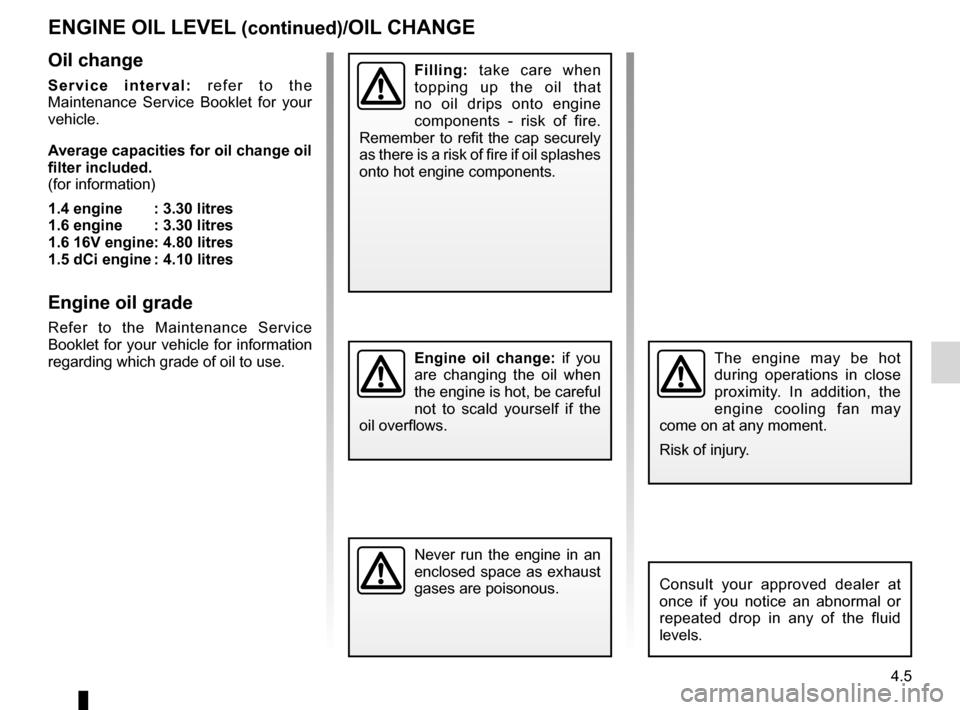
filteroil filter .............................................................(current page)oil change ..............................................................(current page)
JauneNoirNoir texte
4.5
ENG_UD5591_1Niveau huile moteur/Vidange moteur (B90 - Dacia)ENG_NU_817-2_NU_Dacia_4
Vidange moteur
ENGINE OIL LEVEL (continued)/OIL CHANGE
Oil change
S e r v i c e i n t e r v a l : r e f e r t o t h e Maintenance Service Booklet for your vehicle.
Average capacities for oil change oil filter included.(for information)
1.4 engine : 3.30 litres1.6 engine : 3.30 litres1.6 16V engine: 4.80 litres
1.5 dCi engine : 4.10 litres
Engine oil grade
Refer to the Maintenance Service Booklet for your vehicle for information regarding which grade of oil to use.
Filling: take care when topping up the oil that no oil drips onto engine components - risk of fire. Remember to refit the cap securely as there is a risk of fire if oil splashes onto hot engine components.
Engine oil change: if you are changing the oil when the engine is hot, be careful not to scald yourself if the oil overflows.
Never run the engine in an enclosed space as exhaust gases are poisonous.
The engine may be hot during operations in close proximity. In addition, the engine cooling fan may come on at any moment.
Risk of injury.
Consult your approved dealer at once if you notice an abnormal or repeated drop in any of the fluid levels.
Page 95 of 146

engine coolant .......................................................(current page)tanks and reservoirscoolant .............................................................(current page)
JauneNoirNoir texte
4.7
ENG_UD5592_1Niveaux / Filtres (B90 - Dacia)ENG_NU_817-2_NU_Dacia_4
Liquide de refroidissement moteur
Coolant
The level when cold must be between the MINIMUM and MAXIMUM marks
indicated on the tank 2.
Top this level up when cold before it reaches the MIN mark.
The engine may be hot during operations in close proximity. In addition, the engine cooling fan may come on at any moment.
Risk of burns.
Checking intervals
Check the coolant level regularly (very severe damage is likely to be caused to the engine if it runs out of coolant).
If the level needs to be topped up, only use products approved by our Technical Department which ensure:
– protection against freezing;
– anti-corrosion protection of the cool
- ing system.
Replacement intervals
Refer to the Maintenance Service Booklet for your vehicle.
Consult your approved Dealer at
once if you notice an abnormal or repeated drop in any of the fluid levels.
LEVELS (continued)
2
Page 97 of 146

battery...................................................(up to the end of the DU)capacity of mechanical components......................(current page)maintenance:mechanical .......................................................(current page)
4.9
ENG_UD5593_1Batterie (B90 - Dacia)ENG_NU_817-2_NU_Dacia_4
Batterie
BATTERY
Depending on the vehicle, the battery may be a low maintenance version.
Low maintenance battery
A label on the battery will indicate if the battery is the low maintenance type.
The engine may be hot during operations in close proximity. In addition, the engine cooling fan may come on at any moment.
Risk of injury.
Battery requiring
maintenance
Checking intervals:
Every six months, open cover
1.
Remove the plugs and check the level.
Liquid
Distilled or demineralised water to
1.5 cm above the plates.
Never add electrolyte or other prod-
ucts.
Handle the battery with care as it contains sulphuric acid, which must not come into contact with eyes or skin. If it does, wash the affected area with
plenty of cold water.
Ensure that naked flames, red hot objects and sparks do not come into contact with the battery as there is a risk of explosion.
1
As the battery is specific to the vehicle (presence of a ventilation pipe to expel corrosive and explosive gases), make sure that it is replaced
with a battery that enables this pipe to be connected. Consult an ap- proved dealer.
Page 98 of 146
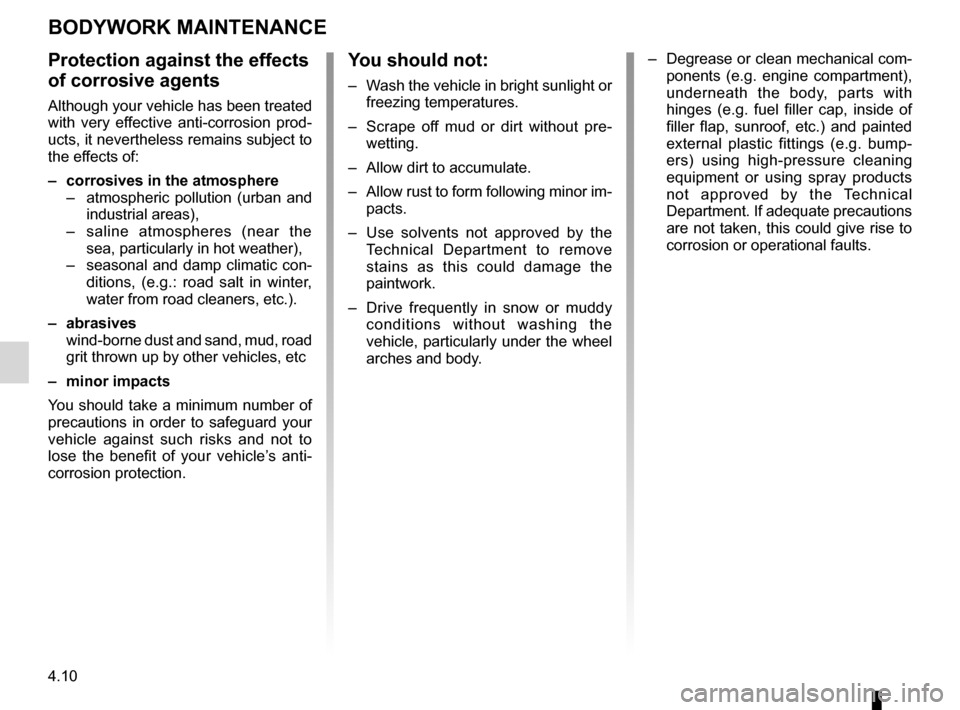
bodywork (maintenance) ......................(up to the end of the DU)maintenance:bodywork ........................................(up to the end of the DU)washing ................................................(up to the end of the DU)paintworkmaintenance ....................................................(current page)
4.10
ENG_UD5594_1Entretien de la carrosserie (B90 - Dacia)ENG_NU_817-2_NU_Dacia_4
JauneNoirNoir texte
Entretien de la carrosserie
BODYWORK MAINTENANCE
Protection against the effects
of corrosive agents
Although your vehicle has been treated with very effective anti-corrosion prod- ucts, it nevertheless remains subject to the effects of:
– corrosives in the atmosphere
– atmospheric pollution (urban and
industrial areas),
– saline atmospheres (near the sea, particularly in hot weather),
– seasonal and damp climatic con- ditions, (e.g.: road salt in winter, water from road cleaners, etc.).
– abrasives
wind-borne dust and sand, mud, road grit thrown up by other vehicles, etc
– minor impacts
You should take a minimum number of precautions in order to safeguard your vehicle against such risks and not to lose the benefit of your vehicle’s anti- corrosion protection.
You should not:
– Wash the vehicle in bright sunlight or freezing temperatures.
– Scrape off mud or dirt without pre
- wetting.
– Allow dirt to accumulate.
– Allow rust to form following minor im
- pacts.
– Use solvents not approved by the
Technical Department to remove stains as this could damage the paintwork.
– Drive frequently in snow or muddy
conditions without washing the vehicle, particularly under the wheel arches and body. –
Degrease or clean mechanical com
- ponents (e.g. engine compartment), underneath the body, parts with hinges (e.g. fuel filler cap, inside of filler flap, sunroof, etc.) and painted external plastic fittings (e.g. bump- ers) using high-pressure cleaning equipment or using spray products not approved by the Technical Department. If adequate precautions are not taken, this could give rise to corrosion or operational faults.